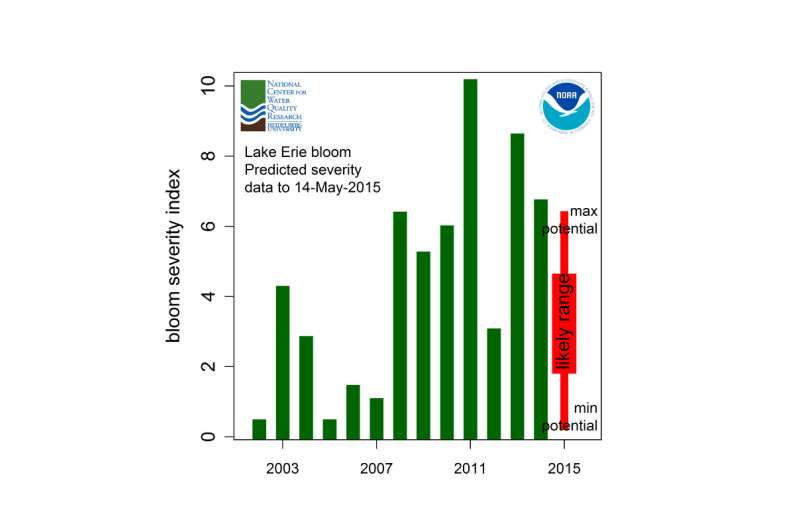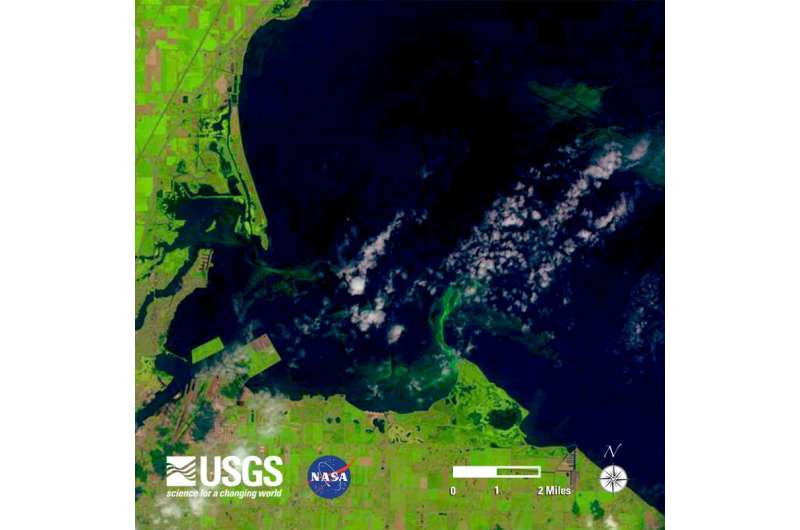Early season forecast updates for Lake Erie harmful algal blooms

In response to increased demand for harmful algal bloom information and data, beginning today, NOAA researchers, and their partners at Heidelberg University, will issue new experimental, early season forecasts of the seasonal harmful algal bloom in western Lake Erie. This information could be used by resource and public health managers deal with the toxic blooms, which can affect human and animal health.
The harmful algal bloom season peaks annually in late summer.
The severity of western Lake Erie harmful algal blooms depends on the amount of phosphorus that comes in to the lake from March 1 through July 31, during what is known as the loading season. This early season forecast estimates the bloom severity based on measurements of phosphorus loading from the Maumee River combined with historical records to create the weekly estimates for the remainder of the loading season. They are also compared with NOAA satellite observations.
"By using the environmental data collected by NOAA and our partners, resource managers in the Great Lakes can be better prepared for when harmful algal bloom events happen in their lakeshore communities," said Holly Bamford, Ph.D., assistant NOAA administrator for NOAA's National Ocean Service performing duties of the assistant secretary of commerce for conservation and management. "As we continue to make advances in ecological forecasting and better understand the severity and timing of blooms, we can help local managers protect their residents and their economies."
The early seasonal forecasts will provide the likely range of severity for the bloom at its peak in August and September. Weekly updates will be compared with the corresponding historical data from the same date, helping lead to a more accurate final season outlook which will be issued on July 9 at Ohio State University's Stone Lab on Lake Erie.
These new experimental forecasts, and the bloom update bulletin which begins in July, will be updated weekly and distributed through NOAA's Experimental Lake Erie HAB Bulletin website.

"This is an extraordinary integration of monitoring systems to help the Lake Erie community, combining river and water sample monitoring with satellite data," said Richard Stumpf, Ph.D., who leads the NOAA ecological forecasting applied research efforts within NOAA's National Centers for Coastal Ocean Science (NCCOS). "We have been monitoring the blooms long enough to capture the likely conditions several months in advance, which should help the community plan for the conditions that are most likely to occur."
Lake Erie has been plagued by a steady increase of HABs over the past decade. These blooms consist of excessive growth of cyanobacteria, or blue-green algae, which are capable of producing toxins that pose a risk to human and animal health, foul coastlines, and hurt communities and businesses that depend on the lake. NOAA has issued weekly bulletins for HABs in Lake Erie since 2008, and increased the frequency to twice weekly last summer.
Lake Erie has had large blooms three of the last four years. The toxins produced by these blooms overwhelmed the water treatment facility in Toledo, Ohio, in August 2014, resulting in a two-day ban on drinking and using tap water.
The advance is possible because of the 15 years of data collected by scientists at NCCOS and Heidelberg University's National Center for Water Quality Research. NOAA has assembled data on bloom magnitude from both the European Space Agency's Envisat satellite and NASA's Aqua and Terra satellites. Heidelberg quantifies the loads of nutrients through a daily monitoring of 16 rivers in Ohio and Michigan including the Maumee River, which is key to this forecast that began in 1974.
While the blooms do not typically start until late July and peak in September, routine monitoring will begin in June. The satellite data will be complemented by field programs of NOAA's Great Lakes Environmental Research Laboratory, Ohio State University's Stone Lab, and the University of Toledo.
Excess nutrients in spring runoff, including high levels of phosphorus, are the primary factors driving these cyanobacterial blooms in Lake Erie. Cyanobacteria produces toxins and when it develops into a dense bloom, the toxins can be found in high enough concentrations to be a hazard to health. In 2014, the bloom peaked in early August, a month earlier than in previous years.
"This forecast presents a tremendous opportunity for state and regional managers and water treatment plant operators to plan and prepare to ensure there is no repeat of the 2014 Toledo water crisis and limited disruption of activities for Lake Erie's citizens and recreational visitors," said Jeff Reutter, Ph.D., senior advisor to and former director of Ohio State University's Sea Grant program and Stone Laboratory.
NOAA, NASA, EPA, and the U.S. Geological Survey last month announced a $3.6 million multi-agency research effort designed to be an early warning system for freshwater nuisance and toxic algal bloom by using satellites that can gather color data from freshwater bodies during scans of the Earth. The project will improve the understanding of the environmental causes and health effects of cyanobacteria and phytoplankton blooms. The effort includes the Great Lakes and will further strengthen initiatives like the NOAA Lake Erie HABs forecast.
"We've been tracking the spring loads from the Maumee River in almost real-time for several years now and will be providing that data starting this year through the Great Lakes Observing System," said Laura Johnson, Ph.D., research scientist at Heidelberg and the primary analyst of the spring Maumee River monitoring. "This forecast is an essential extension of that work to help interpret how this year compares to previous years. More importantly, this forecast helps the public better connect with the environment and start to link their experiences outdoors with future lake conditions."
Provided by NOAA Headquarters

















